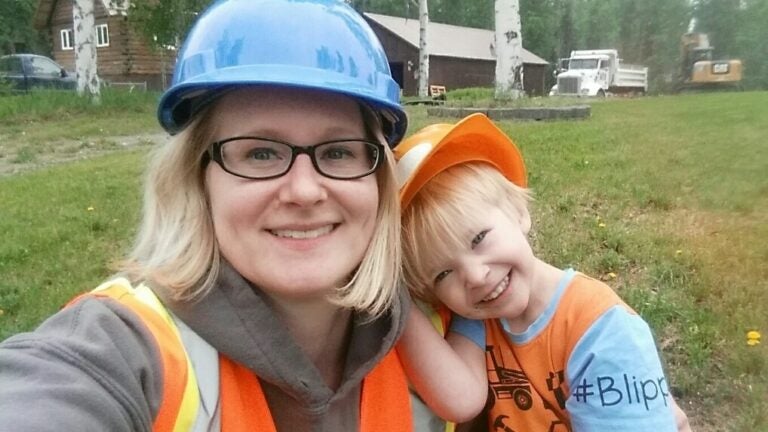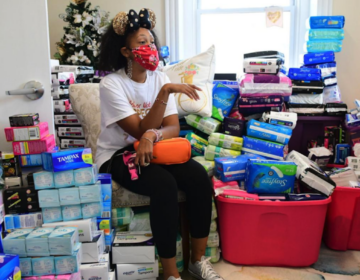How coronavirus could widen the gender wage gap

Mamie Brown, a lawyer in Fairbanks, Alaska, takes a selfie with her son, Edward. She has found herself squeezed between work and caring for her two kids during the coronavirus pandemic. (Mamie Brown)
Mamie Brown is getting up earlier than ever these days.
“A typical day for me starts about 4:30 to 5:00. I actually naturally wake up. I think part of that’s my anxiety right now,” she said. “And then when I do, very first thing in the morning is catch up on to-dos around the house and paperwork.”
She’s a self-employed lawyer in Fairbanks, Alaska, specializing in helping small businesses with things like contracts and HR issues. But now she and her husband are juggling work and their kids, ages 8 and 4.
When schools closed in the spring, the children’s classes moved online. That forced Brown to rejigger her workday so she could help her children with schoolwork.
“I always thought, oh yeah, OK, if I can’t work at 8:00 and 10:00 and noon, I’ll just work at 7:00 p.m. But pretty quickly, you realize that, you know, I have my productive hours, but I have to put my productive hours on hold because my daughter has mandatory things she has to do for her curriculum.”
Brown typically earns more than her husband, Wyatt Hurlbut. He manages rental properties and does repair work and renovations. But that’s work he can’t really do from home, and he gets paid more quickly than she does. For those reasons, Brown is now doing the bulk of the child care.
“Right now he has an opportunity to get cash faster than me,” she said. “And even though it might not be technically as much as I could make if I was doing a full 40 hours, definitely because it’s cash in the hand, that’s better than cash in the bush.”
Every day is a math equation for Brown and her husband, as they analyze her billable hours versus what he can earn.
And as more and more families do these kinds of calculations, it could mean a reversal in economic gains women have made over decades.
Coronavirus has women doing even more work at home
The challenge of juggling work and raising kids has only increased during the pandemic, according to Claudia Goldin, professor of economics at Harvard University.
“We have some information that shows, surprise, surprise, the workload of parents has increased astronomically,” she said.
But, Goldin says, the workload has grown more for moms.
“That [workload], for mothers, has increased to a degree that it’s very difficult to find uninterrupted time during the day to do their work if they’re working at home,” she said.
Before the coronavirus pandemic, working moms already did more child care and more housework than their male partners. Surveys say that coronavirus has widened that gap. One, conducted across five advanced economies including the U.S., found that working moms now spend 15 more hours than working dads on childcare and household chores per week.
A reduction in work hours, as Mamie Brown has experienced, is just one way the coronavirus pandemic could reverse economic gains women made over the last half-century. In addition, the pandemic is pulling women out of work altogether.
There has long been evidence of a “motherhood penalty” that’s a primary driver of the gender wage gap. The pandemic could further widen that gap, which recently had been at its narrowest point ever.
Working away from home
Even with her struggles, Brown is in a few privileged groups: her husband helps with the child care, and she can do her work from home.
She’s also white — a group of women that overall earns more and has lower unemployment than Black and Latina peers. It’s possible that coronavirus could exacerbate those racial and ethnic economic gaps as well.
“Even when jobs start to be regained, women of color are still going to — it’s going to take that group longer to sort of recover from this pandemic,” said Michelle Holder, professor of economics at John Jay College of Criminal Justice.
In addition, tens of millions of essential workers can’t work from home, and many of them need child care in order to do their jobs. Those essential workers are disproportionately women.
“We relied quite heavily on women during this pandemic, not only for work done in the home, but for work done outside the home,” Holder said. “We saw that it was women out there, women as nurses, women as home health aides, as nursing assistants.”
Having to leave home to go to work forces many of those women make tough decisions: for example, whether put kids in child care (if it’s open), as well as how to protect their families from the virus if those women are front line healthcare workers.
A spike in job losses
Already, women have lost more jobs than men during the pandemic. Women’s unemployment rate has shot past men’s rate. That’s unusual in recent recessions. The below chart, depicting women’s jobless rate minus men’s, shows just how unusual this phenomenon is.
Because spending time out of work tends to lower people’s earnings later on, that could play a big role in widening the gender wage gap for years to come, if and when those women go back to work.
A deciding factor in how America recovers will come this fall, when schools reopen…or don’t.
That could be make or break for many families, including Mamie Brown’s in Alaska.
“If we get to the point where the school district is not open in the fall, that means that one of us is going to have to take that full-time leave of being that educator for our kids, on top of childcare.”
If that happens, she says, she will likely be the one at home with the kids.
9(MDAzMzI1ODY3MDEyMzkzOTE3NjIxNDg3MQ001))


![CoronavirusPandemic_1024x512[1]](https://whyy.org/wp-content/uploads/2020/03/CoronavirusPandemic_1024x5121-300x150.jpg)


